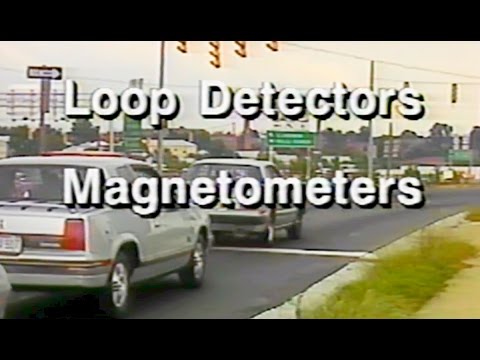more at
“Federal Highway Administration Video VH-584 Traffic Detector Video Training Course – Part 1 – Detector Theory
This training course on traffic detectors provides an understanding of how detectors work and the best methods to install, maintain, and repair them. The course is divided into four parts: detector theory, applications and evolution; detector design; detector installation; and detector maintenance. The training course introduces pressure, push button, magnetic, magnetometer, inductive loop, radar, sonic, radio frequency, and light emission detectors, with emphasis on loop detectors; for application at isolated intersections, in arterial or open network systems, in closed network systems, for area-wide system control, for preemption and priority vehicle control and pedestrian signal control; and in conjunction with pretimed, semi-actuated, fully-actuated and volume density controlled signal timing plans.”
Public domain film from the US National Archives, slightly cropped to remove uneven edges, with the aspect ratio corrected, and mild video noise reduction applied.
The soundtrack was also processed with volume normalization, noise reduction, clipping reduction, and/or equalization (the resulting sound, though not perfect, is far less noisy than the original).
An induction or inductive loop is an electromagnetic communication or detection system which uses a moving magnet to induce an electric current in a nearby wire. Induction loops are used for transmission and reception of communication signals, or for detection of metal objects in metal detectors or vehicle presence indicators. A common modern use for induction loops is to provide hearing assistance to hearing-aid users…
Vehicle detection loops, called inductive-loop traffic detectors, can detect vehicles passing or arriving at a certain point, for instance approaching a traffic light or in motorway traffic. An insulated, electrically conducting loop is installed in the pavement. The electronics unit transmits energy into the wire loops at frequencies between 10 kHz to 200 kHz, depending on the model. The inductive-loop system behaves as a tuned electrical circuit in which the loop wire and lead-in cable are the inductive elements. When a vehicle passes over the loop or is stopped within the loop, the vehicle induces eddy currents in the wire loops, which decrease their inductance. The decreased inductance actuates the electronics unit output relay or solid-state optically isolated output, which sends a pulse to the traffic signal controller signifying the passage or presence of a vehicle. Parking structures for automobiles may use inductive loops to track traffic (occupancy) in and out or may be used by access gates or ticketing systems to detect vehicles while others use Parking guidance and information systems. Railways may use an induction loop to detect the passage of trains past a given point, as an electronic treadle.
The relatively crude nature of the loop’s structure means that only metal masses above a certain size are capable of triggering the relay. This is good in that the loop does not thus produce very many “false positive” triggers (say, for example, by a pedestrian crossing the loop with a pocket full of loose metal change) but it sometimes also means that bicycles, scooters, and motorcycles stopped at such intersections may never be detected by them (and therefore risk being ignored by the switch/signal). Most loops can be manually adjusted to consistently detect the presence of scooters and motorcycles at the least…

